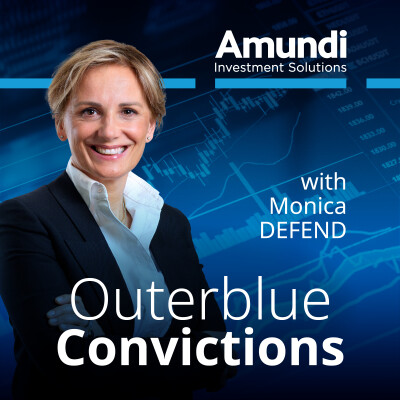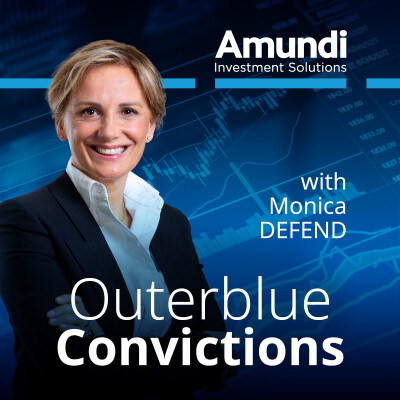- Disclaimer
This podcast is only for the attention of professional investors in the financial industry. Outerblue by Amundi. Welcome to Outerblue Convictions, Market Analysis and Asset Allocation Views.
- Swaha Pattanaik
Hello and welcome to this edition of our monthly Amundi podcast, where we discuss what lies ahead for economies and markets. I'm Swaha Pattanaik, the Head of Publishing, and it's my great pleasure to welcome Monica Defend, the head of the Amundi Investment Institute. Hello, Monica.
- Monica Defend
Hello, Swaha.
- Swaha Pattanaik
Well, it may be the run-up to the summer holidays here in Europe, but the news flow has been unrelenting. A US budget that could add something like $3 trillion to debt over a decade was passed through Congress. There's been much to-ing and fro-ing over tariffs, with US deadlines paused, extended, and new tariff threats sent in so-called letters of intent to a range of countries. Markets seem to be less prone to be rattled than they were six months ago, but there are some topics like Fed independence which are still managing to trigger sharp asset price reactions. We'll get to the central bank issue later, but Monica, perhaps we could kick off with the US budget. What sort of impact do you have in your sort of pencilled in forecast for growth in the US and elsewhere, perhaps?
- Monica Defend
Thank you Swaha. Well, starting from the fiscal boost, we think it will be modest around 0.2%, 0.4% in fiscal year 26. And in any case, it will be short lived. On top of that, we think it will be highly regressive. So, any short-term lift to growth can't obscure the long-term negatives, which includes, as I was saying, negative effects in particular on the low-income groups and in fiscal sustainability, as the market has been pricing in since a while. So tax cuts will take effect immediately. Some of them will be backdated to the beginning of the year, but planned cuts to social spending and being postponed to October 2026. And this will automatically stimulate economic activity in the second half of this year and in the first half of next year. So as a result, we think that the debt threats will likely push up the term premium on the long-term end of the Treasury yield curve. And this will tighten eventually financial conditions. As a result, this will complicate further the life of the Fed when they will try to be more accommodative cutting rates in the remainder of this year.
- Swaha Pattanaik
So you're talking about the complication in the Fed's life, quite a few complications. We'll come to one of the other ones later. But just on that monetary policy tightrope that they've been walking for a while, what are you expecting them to do through the rest of this year?
- Monica Defend
For the time being, we have not been changing our expectations on the Fed, so we see still three cuts in the pipe, starting likely in September towards year-end. It will be quite important to look at the employment number and inflation, because this is what the Fed will have to ponder. And we do expect employment and in general economic activity to continue to decelerate while we are seeing some of the tariff's effects and spillover kicking in. So it will be a very difficult job for the Fed, considering also the political pressure that is now on Fed Chair Jay Powell.
- Swaha Pattanaik
So talking about the political pressure that's on this, this is one thing that's rattled all of the US dollar denominated assets across the board. Could you explain a little bit why and how this is so important fundamentally, given, you know, some sceptics about whether it will matter or not, could say that it's the overall FOMC votes that will count not just one person's. Why is this so important? And it really is.
- Monica Defend
One of the golden rules of the central bank's activity is their independence. And this is what is currently challenged by the US administration. So no matter whether it's the FOMC or the chair, it's a threat to the central bank. And I'm convinced that the liquidity and the depth of the US market - Treasuries and US dollar - are strictly related to this reputation of independence of the central bank. And this is why the market is currently worried. And we've seen the movement and the challenge in particular on the US dollar, I would say.
- Swaha Pattanaik
Thanks, Monica. So you're talking about risks from the fiscal outlook, the risks from political interference in the independent central bank. What's your view on fixed income, given both of those things really go to the heart of what drives fixed income markets?
- Monica Defend
Well, we don't think there is a directionality on the rates front. While we still prefer a steepening of the curve, there is a challenge to this scenario that is coming exactly from the effect that a potential increase of the deficit might have on higher growth and higher inflation. And this could eventually push the Fed to tighten policy. But in this scenario, we think the yield curve could move upward both on the short end and the long end. We think that fiscal credibility will become a critical factor, actually is a critical factor, differentiating across developed markets, which is something new because we used to see this as a feature of the emerging markets. So in our view, probably yields of government bonds appear too fiscally related, like in the UK and in the US, and we will continue to see pressure on the long end of the curve.
- Swaha Pattanaik
Thanks, Monica. So we're talking a lot about the fiscal outlook and the Fed's independence. But there's one thing that's been sort of looming over the economy and markets since the start of the year, since Donald Trump took up presidency in the White House the second time; tariffs. We've talked a lot about them, but are we seeing any real impact on growth and inflation from the levies yet?
- Monica Defend
Well, probably on inflation. It is starting much slower than expected, but this is because eventually part of the tariff has been removed or lowered. To be honest, we are not changing our growth forecast for now. We would like to wait for August 1st and the results of the second quarter. So probably by the end of next month, we will review our projections. What we have been doing so far is some stress analysis and as we often mentioned the tariffs will be detrimental to growth in Europe, but in some countries in emerging markets as well, and will move into higher inflation.
- Swaha Pattanaik
Thank you Monica. So growth data, obviously, and inflation data, hard economic macro data, comes with the lag. We always look for an early warning indicator in the earnings seasons. What are you seeing in this US earnings season?
- Monica Defend
Well, the U.S. earnings season is really at the beginning. We will see how the financial sector will be reporting. The uncertainty on tariff negotiations will wait on the guidelines. The consensus has been progressively slashing the expectations on the EPS growth, but still they are much higher than what we see. For the time being, we are still in the camp of 5% to 6%. There are two potential risks, one on revenues, in case tariffs will hit growth and probably this is where we think the risk is higher on margins, so on the cost side. And this is why, as I was saying, we have this 5% to 6% earnings growth projection on the S&P 500.
- Swaha Pattanaik
That's really interesting to hear. So, especially since the sort of moves we're seeing in markets, in equity and credit markets, which seem to be taking pretty much everything in their stride so far. How appealing do these assets seem to you at the moment, given where valuations are?
- Monica Defend
Well, you know, valuation remains quite expensive, in particular in the US,so probably this is a moment for stock picking. We maintain our positive stance on Europe, in particular on the small and medium caps, on Japan and the UK, while we are more cautious on US growth. On credit, selection again will be key. We maintain our preference for the investment grade in the Euro area and subordinated debt, while we move to neutral on high yield. Carry is strong on IG in the Euro area and BBB, BBB rated credit with medium term maturities are the ones that we prefer. From a sectoral perspective, we like banks, insurance and real estate.
- Swaha Pattanaik
So we've been talking a lot about the impact on the US of all the factors, macro factors that you've been discussing. EM economies, some of them have been at the forefront of the tariff salvos being directed from the US. How much has all of this uncertainty affected them so far?
- Monica Defend
Well, Asia remains at the centre of the storm, but emerging market assets have shown resilience so far. And the long-term backdrop, in our opinion, remains constructive due to robust economic growth, less inflation vulnerability and an improvement both on the external and fiscal positions that these countries have been able to build over over time with inflation that all in all remains contained. We like both local currency and hard currency emerging debt. In particular on the local currency, we are positive on LATAM and countries where real yields attractive. While on the hard currency, we prefer a high yield over investment grade and are selective in regions such as Sub-Saharan Africa and emerging Europe. While in equities, we still focus on the domestic, country-specific and idiosyncratic factors. So in Asia, we believe that Indian markets and technology sector in Taiwan are likely to continue to perform well, even if trade negotiations with the US could act potentially as a near-term dampener.
- Swaha Pattanaik
Monica, thank you so much for covering all this ground in such a short space of time.
- Monica Defend
Thank you, Swaha.
- Swaha Pattanaik
And thank you all of the listeners for tuning in. We hope the summer won't be torrid, either in temperatures or in markets. And we will be back after the summer with no doubt a lot of developments to catch up with and discuss here on the Convictions podcast with Monica. In the meantime, have a good break.
- Disclaimer
This podcast is only for the attention of professional investors as defined in directive. 2014-65-EU, dated 15 May 2014, as amended from time to time on markets and financial instruments, called MIFID II. Views are those of the author and not necessarily Amundi Asset Management SAS. They are subject to change and should not be relied upon as investment advice, as a security recommendation, or as an indication of trading for any Amundi products or any other security, fund units, or services. Past performance is not a guarantee or indicative. of future results.






